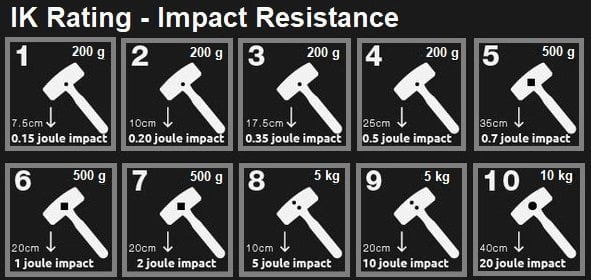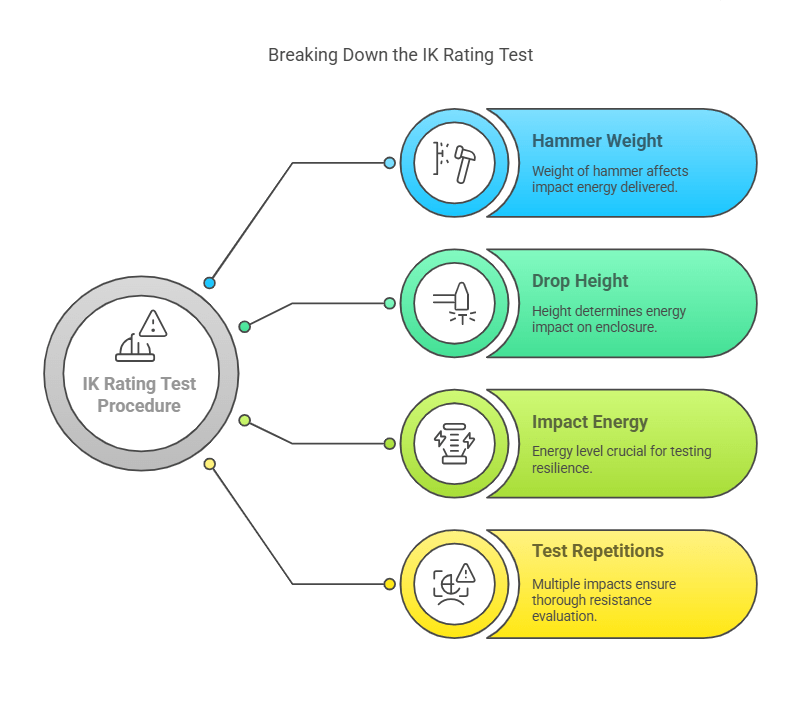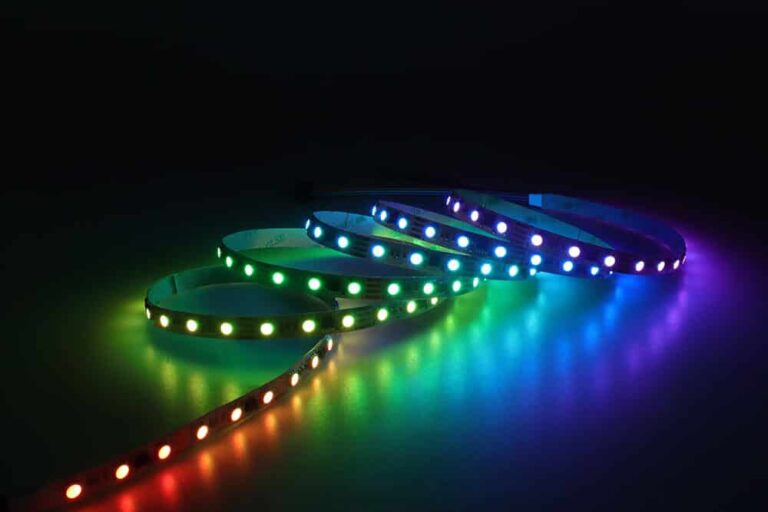What Is IK Rating? What You Need to Know
Table of Contents
When investing in an electrical device, its durability is a paramount consideration. The product’s reliability often hinges on its IK rating, making it vital to review this when choosing any electrical appliance.
The IK rating gauges a product’s protection against potential impacts. Both indoor and outdoor enclosures can be subjected to unforeseen events, such as strikes or drops. Understanding its IK rating is essential to ensure the device’s safety and durability in these scenarios. Each rating signifies a distinct threshold of resistance.

This guide will delve deep into the nuances of the IK rating, including its importance, applications, and methods to ascertain it. We’ll also recommend appropriate IK ratings for various lighting fixtures. Let’s dive in.
Understanding the IK Rating
The IK Rating, or Impact Protection rating, measures an electrical enclosure’s protection level against mechanical impacts.
This rating system was first introduced in 1995 by the European standard BS EN 50102. Later adjustments were made in 1997, aligning it with IEC 60068-2-75. By 2002, the European Standard EN62262 emerged, matching the International Standard IEC 62262 guidelines.
Before establishing the IK rating, manufacturers often included an extra number within the ingress protection (IP rating) to signify impact resistance. This number, such as the (9) in “IP66(9)”, was termed the anti-impact code. However, this system was non standardized and thus led to confusion. The IK system was rolled out in 1995 to clarify and unify impact protection ratings.
At its core, the IK rating offers valuable insights into electrical enclosures. It reveals the number of impacts a device can withstand, the environmental conditions it can endure, and even specifics about the tool used to test its resilience, like the hammer’s size, dimension, and composition.
The IK rating gauges an enclosure’s capacity to resist sudden or aggressive impacts.
Deciphering IK Rating Numbers
Every digit within the IK rating holds specific information. The rating spans from 00 to 10, with each number representing varying degrees of impact protection. As the number rises, so does the level of security. For instance, an LED light rated IK08 provides superior impact protection compared to one rated IK05.
IK Rating Breakdown
Using the IK rating, one can assess the resilience of any electrical enclosure. Here’s a quick look at different IK ratings and what they indicate in terms of impact protection-
| IK Rating | Protection | Impact |
| IK00 | Not Protected | – |
| IK01 | Protected against 0.14 joules impact | Equivalent to 0.25 kg of mass falling from 56 mm above the impacted surface |
| IK02 | Protected against 0.2 joules impact | Equivalent to 0.25 kg of mass falling from 80 mm above the impacted surface |
| IK03 | Protected against 0.35 joules impact | Equivalent to 0.25 kg of mass falling from 140 mm above the impacted surface |
| IK04 | Protected against 0.5 joules impact | Equivalent to 0.25 kg of mass lowering from 200 mm above the impacted surface |
| IK05 | Protected against 0.7 joules impact | Equivalent to 0.25 kg of mass falling from 280 mm above the impacted surface |
| IK06 | Protected against 1 joules impact | Equivalent to 0.25 kg of mass falling from 400 mm above the impacted surface |
| IK07 | Protected against 2 joules impact | Equivalent to 0.50 kg of mass lowering from 56 mm above the impacted surface |
| IK08 | Protected against 5 joules impact | Equivalent to 1.70 kg of mass falling from 300 mm above the impacted surface |
| IK09 | Protected against 10 joules impact | Equivalent to 5 kg of mass lowering from 200 mm above the impacted surface |
| IK10 | Protected against 20 joules impact | Equivalent to 5 kg of mass falling from 400 mm above the impacted surface |
Characteristics of the Impact Test
The IK rating impact assessment evaluates factors like the energy exerted in joules, the striking element’s radius, material, and weight. The procedure also encompasses the falling height and three distinct hammer impact tests: the pendulum hammer, spring hammer, and free fall hammer.
| IK code | IK00 | IK01-IK05 | IK06 | IK07 | IK08 | IK09 | IK10 |
| Impact Energy (Joules) | * | <1 | 1 | 2 | 5 | 10 | 20 |
| The radius of the striking element (Rmm) | * | 10 | 10 | 25 | 25 | 50 | 50 |
| Material | * | Polyamide 1 | Polyamide 1 | Steel 2 | Steel 2 | Steel 2 | Steel 2 |
| Mass (KG) | * | 0.2 | 0.5 | 0.5 | 1.7 | 5 | 5 |
| Free Fall Height (M) | * | * | * | 0.40 | 0.30 | 0.20 | 0.40 |
| Pendulum hammer | * | Yes | Yes | Yes | Yes | Yes | Yes |
| Spring hammer | * | Yes | Yes | Yes | No | No | No |
| Free fall hammer | * | No | No | Yes | Yes | Yes | Yes |
The diagrams show that IK10 offers the utmost protection, withstanding an impact that generates 20 joules of energy from a 5 kg weight.
Key Elements in IK Rating Tests
Several factors come into play when you’re evaluating an electrical enclosure using the IK rating system. Here’s a breakdown:
1. Impact Energy
This refers to the energy required to breach an enclosure under set conditions, expressed in joules (J). To illustrate, a LED neon flex-rated IK08 can endure an impact energy of 5 joules. This means that if a 1.70 kg object falls from a height of 300 mm and hits the neon flex, it remains unharmed.
2. Impact Material
The type of material causing the impact plays a pivotal role in the IK test. For ratings IK01 through IK06, Polyamide 1 is the impact material of choice. However, steel is employed for ratings IK07 to IK10. Given steel’s superior strength compared to Polyamide 1, products rated IK07 to IK10 offer more excellent protection.
3. Fall Height
The height from which the impacting object falls during an IK test is rating-specific. For instance, in an IK09 test, the thing is dropped from 0.20 meters onto the test enclosure. Meanwhile, for an IK10 test, the drop height is 0.40 meters. The implication is that to earn a higher IK rating, the section must withstand impacts from greater heights.
4. Hammer Test Varieties
Three distinct hammer tests are utilized in IK rating testing: the spring hammer, pendulum hammer, and free fall hammer. Here’s a concise overview of each:
4.1. Spring Hammer Test
Designed to evaluate resistance against routine interference, the spring hammer test applies for IK01 to IK07 ratings.
4.2. Pendulum Hammer Test
The pendulum hammer test covers all IK ratings and offers a more rigorous testing method than the spring hammer. Even devices with an IK10 rating must undergo this test to guarantee enhanced impact protection.
4.3. Free Fall Hammer Test
The most formidable of the three, the free fall hammer test, surpasses both spring and pendulum tests in intensity. This method is tailored for the higher end of the IK spectrum, specifically IK07 to IK10 ratings.
5. Impact Mass
The weight of the impacting object in the test also changes based on the desired IK rating. For example, to ascertain if a light fixture qualifies for an IK07 rating, it must withstand the blow from a 0.5kg object. As the IK rating escalates, so does the mass of the impacting object.
6. Corresponding to IP Rating
The IK rating of a casing should align with its ingress protection (IP) rating. For instance, if a light fixture achieves IP66 and IK06, it should be designated accordingly. However, if the same institution reaches IK08 but only IP54, it cannot carry IP66 and IK08 labels. In such a scenario, it’s appropriate to label it either ‘IP66 and IK06’ or ‘IP54 and IK08’.
Keep these considerations in mind when evaluating the IK rating test.
How to Conduct an IK Rating Test?

To evaluate the IK rating, a specific procedure known as the ‘control dropping’ method is implemented in an appropriate setting. This involves delivering a designated amount of energy to the enclosure to determine its resilience. The primary factors influencing the IK rating test are:
- The spacing between the test enclosure and the hammer.
- The hammer’s weight.
For the test, a set weight is positioned at a defined height and angle over the enclosure. This weight is then let go, allowing it to impact the section with a precise energy level. This action is performed thrice on the same spot. The weight hits the square without rebounding to validate robust impact resistance, targeting multiple points on the section.
Enhancing Your IK Rating
The IK rating is a pivotal metric when evaluating the durability of electrical devices. If you’re looking to enhance this rating, here’s a breakdown of three strategies:
- Material Selection. The material used for the enclosure significantly affects its IK rating. For optimum resistance against impacts, consider the following:
- Stainless Steel: Undoubtedly, stainless steel stands out as a premier choice due to its unparalleled impact resistance, though it’s a pricier option.
- Glass Reinforced Polyester: This sturdy material offers commendable resistance to impact. However, it’s worth noting its susceptibility to UV radiation and the fact that it isn’t eco-friendly.
- Polycarbonate: Emerging as a contemporary choice for enclosures aimed at better IK ratings, polycarbonate is both UV-resistant and non-corrosive. Plus, it’s recyclable, marking a point for sustainability.
- Opt for Thickness. A more robust enclosure typically translates to enhanced protection from impacts. Electrical devices with heftier squares are likelier to achieve higher IK ratings, amplifying the device’s lifespan.
- Ingenious Designing. The design and shape of an enclosure can be instrumental in diffusing impact. Aim for designs that spread impact energy over a wider surface, reducing localized damage. Rounded squares lead the pack in this aspect. The absence of corners, typically vulnerability points, means the round design distributes impact energy more efficiently, offering superior protection compared to enclosures with sharp edges.
By incorporating these principles, you’ll be well on your way to boosting the IK rating of your electrical enclosures.
Where Can You Find IK-Rated Products?
IK-rated items are commonly found in environments with elevated external damage or exposure risk. Electrical devices that are exposed to challenging environmental conditions and might sustain more considerable impacts typically possess a high IK rating. The primary locations for IK-rated products include:
- Industrial zones
- Areas with heavy foot traffic
- Publicly accessible locations
- Correctional facilities
- Educational institutions, among others.
Understanding IK Ratings for LED Lights
The IK rating for LED lights clearly indicates how resistant the internal circuitry is to mechanical impacts. It reveals if the light will continue to function after potential damage. These ratings are indispensable for those in the lighting sector, especially for outdoor fixtures. This is because outdoor lighting is routinely exposed to adverse environmental factors, posing a risk to the integrity of the lamps. As such, verifying the protective capacity of light to ensure it aligns with industry or national standards becomes paramount. Recognizing this, it’s evident why IK ratings are a critical consideration when buying floodlights, street lights, stadium lights, or other specialized outdoor fixtures. Here’s a brief overview of the most appropriate IK ratings for various outdoor lighting categories:
The IK rating should be among your primary concerns if you want to mount fixtures outside. For enhanced protection, especially in industrial contexts, aim for a higher IK rating.
Decoding the IK Rating: Hammer Tests for LED Lights
IK ratings span from IK01 to IK10. For LEDs, determining this rating involves hammer tests split into two categories. The initial category, covering IK01 to IK06, utilizes the spring impact hammer test. Meanwhile, the subsequent type from IK07 to IK10 employs the pendulum test. A more in-depth look at these two tests is provided below:
1. Spring Impact Hammer Test (IK01 to IK06):
This test aims to gauge a light’s resilience against frequent, ordinary impacts. The apparatus uses a spring hammer and features a conical design complemented by a spring lock mechanism. As the cone side is depressed, the opposite end with the compressed spring impacts the light being tested. This process is continually repeated to finalize the assessment.
Lights aiming for ratings between IK01 to IK06 undergo this test. These ratings, typically reserved for indoor fixtures, represent a lower impact energy spectrum, ranging from 0.14J to 1J. As such, indoor lights like downlights and high bay lights are subjected to the spring hammer impact test.
2. Pendulum Test (IK07 to IK10):
This rigorous test evaluates a fixture’s utmost protective capabilities. It involves a set weight affixed to a pendulum, which impacts the light from a predetermined height. Lights seeking ratings from IK07 to IK10 must endure this test, which demands a higher energy threshold spanning 2J to 20J. Notably, the pendulum test is integral to the IK assessment of streetlights, stadium lights, and explosion-proof lights.
Guidelines for the IK Rating Test of Light Fixtures
When assessing the IK rating for light fixtures, consider the following key points:
- Testing conditions are crucial. As per IEC 62262, it’s recommended to test at temperatures between 15°C and 35°C. Air pressure should be maintained between 86 kPa and 106 kPa.
- Ensure you impact the entire enclosure during testing. This ensures that the light fixture is comprehensively protected.
- Always test lights when they are fully assembled and installed. This ensures that the end product is assessed for its accurate IK rating.
- No specific pretreatment is required for the sample lights. Furthermore, keep the light off during the test to avoid any potential accidents. Always disconnect the power source to prevent any electrical mishaps.
- If the installation site of the luminaire could influence the test results, it’s advisable to conduct the test at that specific location.
- In cases where the luminaire’s design makes impact testing unfeasible, an alternate luminaire may be employed. However, ensure that replacements do not compromise the original fixture’s mechanical integrity.
Understanding the LED Neon Flex’s IK08 Test Certification
An LED neon flex must withstand a specific pendulum hammer test to be certified with an IK08 rating. The neon flex is securely anchored during this assessment, and a pendulum hammer is swung to strike it from 300mm, or 0.03m. This action is performed multiple times at various sections of the flex. If the LED neon flex endures these hits without damaging its internal components and continues functioning, it earns its IK08 rating.
An LED neon flex boasting an IK08 certification is ideal for indoor and outdoor illumination, showing resilience in challenging environmental scenarios. If superior-quality LED neon flex is what you’re after, consider MyLikeLed. Our neon flex not only carries the IK08 rating but also offers protection up to IP68, ensuring our products are sturdy, water-resistant, and capable of withstanding extreme climatic challenges.
The Significance of Highlighting the IK Rating
The IK rating is essential when buying electrical gadgets, including lights, smartphones, and cameras. But what makes the mention of IK ratings on products so pivotal? Let’s delve into the reasons:
- Assurance of Superior Quality: Incorporating an IK rating in a product’s specifications signifies its superior quality, setting it apart from rival brands.
- Elevation of Brand Reputation: A reputable brand goes the extra mile in providing comprehensive product details to its customers. Incorporating various tests with the fundamental IK rating, showcases the brand’s commitment to quality, enhancing its reputation.
- Enhancement of Trustworthiness: An IK rating highlights the product’s capacity to resist impacts. This vouches for the product’s protective capabilities and fortifies customers’ trust in the brand.
- Prolonged Product Longevity: Products boasting higher IK ratings typically employ premium materials, ensuring robust protection against adverse environmental factors. As a result, such products, backed by commendable IK ratings, tend to have a prolonged lifespan.
Consequently, the IK rating offers insights into the suitability of a product for various applications. For instance, fixtures with low IK ratings might not be ideal for outdoor use. It’s essential to scrutinize the IK rating when evaluating a potential purchase.
IP Rating vs. IK Rating
Both IP and IK ratings are frequently referenced in the context of gauging the resilience and longevity of electrical devices. They stand as indicators of a product’s resistance and durability. Nevertheless, they serve distinct purposes and differ in the following ways:
| IP Rating | IK Rating |
| IP rating stands for Ingress Progression. | IK rating stands for Impact Protection. Here, ‘K’ defines ‘Kinetic’; it is used to differentiate from IP rating. |
| It indicates the level of protection of any enclosure from solid and liquid ingress. | The IK rating indicates an enclosure’s resistance level against any impact. |
| The standard EN 60529 (British BS EN 60529:1992, European IEC 60509:1989) defines IP ratings. | The standard BS EN 62262 relates to IK ratings. |
| The IP rating is graded using a two-digit number. Here, the first digit indicates the protection against solid ingress, and the second digit determines the protection against liquid ingress. | IK rating has one number to indicate the degree of protection and is graded from IK00 to IK10. The higher the IK rating, the better protection it provides against impact. |
| The factors- dustproof, water resistant, etc. are related to IP rating. | It involves impact energy, hammer test, etc. |
| For example- a neon flex with an IP68 rating means it is entirely dust and waterproof. | For example- a neon flex with IK08 indicates it can resist 5 joules of impact. |
Conclusion
The IK rating is a pivotal element when selecting electrical devices. It reflects the device’s resilience and capability to withstand challenging environments. Therefore, reviewing the IK ratings and selecting the one that matches your requirements is imperative.
Similarly, the significance of the IK rating in lighting cannot be overstated. It provides insights into the light fixture’s performance when subjected to impacts or strokes. The IK rating also helps differentiate whether an institution is apt for indoor or outdoor usage. For instance, institutions with lower IK ratings (IK01 to IK06) are ideal for interior illumination, while those with higher IK ratings (IK07 to IK10) are indispensable for exterior settings. If you’re in the market for a high-quality, durable LED neon flex, consider MyLikeLed. Our IK08-rated LED neon flex is versatile and suitable for indoor and outdoor applications.
FAQs
IK rating is important because it shows how well a light fixture can handle impacts, such as bumps, vandalism, or rough usage—especially in public or outdoor areas.
IK ratings range from IK00 (no protection) to IK10 (the highest level of protection), showing how resistant a product is to physical impact.
Lights with a high IK rating are commonly used in places like industrial zones, public transport stations, schools, and outdoor areas where durability is crucial.
No, they are different—IK ratings measure impact resistance, while IP ratings measure protection against water and dust.
The rating you need depends on where the light will be used. For outdoor or industrial environments, you should look for IK08 or higher.
Yes, some LED strip lights do have IK ratings, especially the ones made for outdoor or heavy-duty commercial use.

Hi, I’m Xylia Xiong, a sales professional with 14 years of experience in the LED strip light industry. I specialize in providing tailored solutions, leveraging my expertise in LED products and the latest industry trends. Known for effective communication and problem-solving, I’m dedicated to helping lighting manufacturers, importers, and distributors achieve their goals.
Let’s work together to create customized solutions that exceed expectations.
Related Posts

The Best LED Strip Lights You Can Buy Right Now

Comparing WS2811 Vs WS2812B: Key Differences


